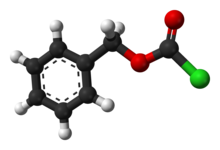
Back بنزیل کولوروفرمات AZB Benzyl-chlorformiát Czech Chlorameisensäurebenzylester German Benzila kloroformiato Esperanto بنزیل کلروفرمات Persian Bentsyyliklooriformiaatti Finnish Chloroformiate de benzyle French Benzil kloroformat ID Benzil cloroformiato Italian クロロギ酸ベンジル Japanese

| |

| |
| Names | |
|---|---|
| Preferred IUPAC name
Benzyl carbonochloridate | |
| Other names
Benzyl chloroformate
Benzyloxycarbonyl chloride Z-Chloride | |
| Identifiers | |
3D model (JSmol)
|
|
| ChemSpider | |
| ECHA InfoCard | 100.007.205 |
| EC Number |
|
PubChem CID
|
|
| RTECS number |
|
| UNII | |
| UN number | 1739 |
CompTox Dashboard (EPA)
|
|
| |
| |
| Properties | |
| C8H7ClO2 | |
| Molar mass | 170.59 g·mol−1 |
| Appearance | colorless liquid, may appear yellow due to impurities |
| Odor | pungent |
| Density | 1.195 g/cm3 |
| Boiling point | 103 °C (217 °F; 376 K) (20 Torr) |
| degrades | |
Refractive index (nD)
|
1.519 (589 nm) |
| Hazards | |
| GHS labelling: | |
 
| |
| Danger | |
| H314, H410 | |
| P260, P264, P273, P280, P301+P330+P331, P303+P361+P353, P304+P340, P305+P351+P338, P310, P321, P363, P391, P405, P501 | |
| Flash point | 80 °C (176 °F; 353 K) |
| Safety data sheet (SDS) | External MSDS |
Except where otherwise noted, data are given for materials in their standard state (at 25 °C [77 °F], 100 kPa).
| |
Benzyl chloroformate, also known as benzyl chlorocarbonate or Z-chloride, is the benzyl ester of chloroformic acid. It can be also described as the chloride of the benzyloxycarbonyl (Cbz or Z) group. In its pure form it is a water-sensitive oily colorless liquid, although impure samples usually appear yellow. It possesses a characteristic pungent odor and degrades in contact with water.
The compound was first prepared by Leonidas Zervas in the early 1930s who used it for the introduction of the benzyloxycarbonyl protecting group, which became the basis of the Bergmann-Zervas carboxybenzyl method of peptide synthesis he developed with Max Bergmann.[1][2] This was the first successful method of controlled peptide chemical synthesis and for twenty years it was the dominant procedure used worldwide until the 1950s.[1] To this day, benzyl chloroformate is often used for amine group protection.
- ^ a b Katsoyannis, P. G., ed. (1973). The Chemistry of Polypeptides. New York: Plenum Press. doi:10.1007/978-1-4613-4571-8. ISBN 978-1-4613-4571-8. S2CID 35144893. Archived from the original on 2022-10-13. Retrieved 2021-04-01.
- ^ Bergmann, Max; Zervas, Leonidas (1932). "Über ein allgemeines Verfahren der Peptid-Synthese" [On a general method of peptide synthesis]. Berichte der deutschen chemischen Gesellschaft. 65 (7): 1192–1201. doi:10.1002/cber.19320650722.